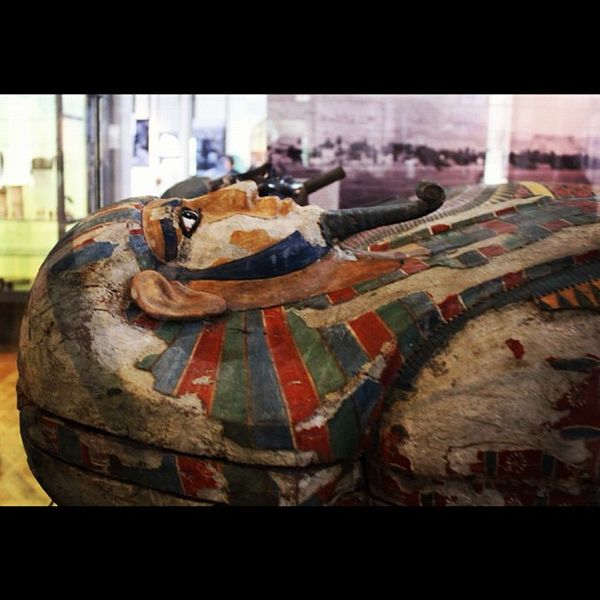Image: Day 4 - Coffin of Khnum-nakht (8153981962)

Description: Coffin of Khnum-nakht (Acc. 4740) Most tombs from ancient Egypt were robbed soon after they were sealed. The complete tomb group of the Two Brothers is one of the few found untouched. This is the wooden inner coffin of a man named Khnum-nakht, from the 'Tomb of the Two Brothers'. It measures 162cm in length. This coffin was designed to lie inside the rectangular outer coffin (acc, 4725). This inner coffin takes the shape of a wrapped mummy, wearing a royal 'nemes' head-dress, a braided royal and divine beard, and a large beaded collar, which helped protect the deceased. The royal beard and head-dress seem to refer to the god of the dead, Osiris, who was a mythical king before his murder and mummification. The body of the coffin is painted red and patterned in imitation of a blue-green beaded net, another protective design. The face of the coffin is painted yellow, which may refer to the shining appearance of gods and the honoured dead. The eyes of the coffin are made of stone and inlaid, held by bronze rims. The coffin is from the Middle Kingdom (12th Dynasty). It was donated to the Manchester Museum in 1907 by the British School of Archaeology in Egypt. The tomb of the two brothers, Khnum-Nakht and Nekht-Ankh, was discovered in 1907 at Rifeh in Middle Egypt, by a workman called Erfai, working under the supervision of British Egyptologist Ernest Mackay in the course of official excavations directed by Sir William Flinders Petrie (1852-1942), within the British School of Archaeology. The contents of the burial site were passed to the Manchester Museum where they were studied by Dr. Margaret A. Murray (1908) and more recently by Prof. Rosalie David (1979). The mummy of the adult male named Khnum-nakht, son of the lady Aa-Khnum is thought to have been around 40 years old at his death. When unwrapped the soft tissue had disintegrated into a fine powder; very little skin tissue remains on the bones. This body seems less well preserved than that of his brother, Nakht-ankh (acc. 11724). In 1908, in a large lecture theatre in Manchester University before a capacity audience, Dr. Margaret Murray unwrapped the mummies of the 'Two Brothers'. This was an important development in scientific investigation, for it involved a multi-disciplinary team. These specialists - in the fields of anatomy, chemistry and textiles - subsequently carried out a full-scale investigation of the mummies. There is comparatively little evidence of mummification from the Middle Kingdom (c.1900 BC) and the bodies that have been examined show that there was generally less painstaking preparation than in the Old Kingdom. The internal organs were removed, but less attention was given to the preservation of the body. Usually a thin cost of resin was applied to the skin surface, and this left the drying out of the body incomplete, so that decomposition soon set in. Although great care was often lavished on the outward appearance of the mummies, inside there is usually only a jumble of bones with little or no evidence of soft tissue. The mummy of Khnum-Nakht is a good example of the poor standard of preservation achieved in the Middle Kingdom. There was very little remaining skin tissue and most of the remnants resolved into a fine powder at the unwrapping. Also, no special care had been taken to preserve his nails. Khnum-Nakht's spine shows evidence of long-standing arthritis with abnormal curvature (scoliosis) in the thoracic region. Inspection of the teeth has revealed an extremely rare developmental abnormality - double gemination (fusion of the teeth); the two central teeth are abnormally large and the left one has two roots.
Title: Day 4 - Coffin of Khnum-nakht (8153981962)
Credit: Day 4 - Coffin of Khnum-nakht
Author: akhenatenator
Usage Terms: Creative Commons Zero, Public Domain Dedication
License: CC0
License Link: http://creativecommons.org/publicdomain/zero/1.0/deed.en
Attribution Required?: No
Image usage
The following page links to this image:

